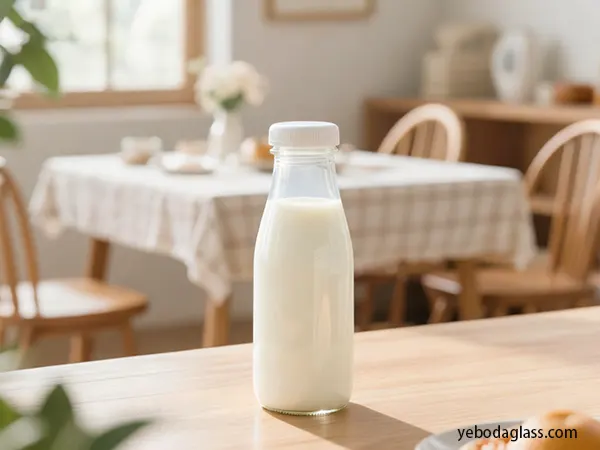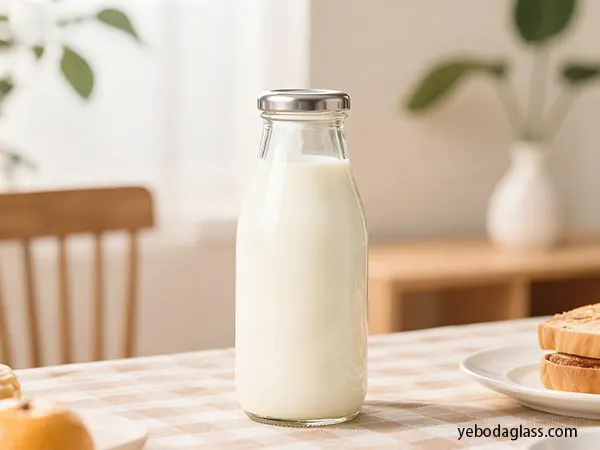Introduction
The worldwide milk bottle sector is ready for a major change in 2026, according to the report, with sustainability requirements, innovations, and consumer preferences being the main factors. This manual is packed with insights on trends, competitive dynamics, and strategic consequences not only for milk bottle suppliers but also for the whole dairy packaging sector. The scenario of the industry changes radically if we take into account the shift to a circular economy model that is focused on recycled materials (rPET, rHDPE), bio-based sources, and reusable solutions such as glass milk bottles. In order to be successful, companies have to focus on supply chain resilience, on efficient operations through automation, and on compliance with regulations. Conversely, pricing decisions influenced by the volatility of materials and energies will compel companies to put in place strong cost management strategies. Ultimately, the milk bottle suppliers who will be the most successful in 2026 are those that will be first to lead in material and design innovation, supply chain optimization, and product portfolio alignment with consumer expectations for convenience and sustainability.

Introduction & Scope
This document is a source of intelligent data for dairy processors, packaging manufacturers, investors, and retailers to understand the changes in the milk bottle market for 2026.
Geographic and Market Scope
The scope of our research is the three major areas of the world – North America, the European Union, and the Asia-Pacific region. We focus on their distinct regulations and consumer behaviors. Our study also embraces all essential milk bottles and container materials – glass bottles, HDPE, PET, rPET, and bio-based plastics like PLA and PHA.
Objective
To begin with, the study is aimed at revealing the market’s present state, predicting its future direction till 2026, and outlining strategic imperatives for each milk bottle supplier. In doing so, it becomes essential to understand the pressures from sustainability, the new technologies, and the regional changes that affect the worldwide supply network of glass milk bottles and plastic packaging.
Milk Bottle Market Overview & 2026 Outlook
The milk bottle market is a significant player in global dairy operations. It will definitely breathe fresh air and develop further in 2026. However, the material compositions and regional dominance will change sharply.
Material Evolution and Market Share
HDPE has long been the top choice of milk bottles due to its low cost and good performance, but the need for sustainability is causing the market to less and less rely on this single solution. To meet these requirements, manufacturers seek PET to pack a long-life milk while organic and premium sectors through glass regain renewed trust thanks to purity and recyclability. Also, bioplastics such as PLA and PHA are becoming popular in places that promote the bio-economy industry.
Material Projections for 2026
- HDPE: Keeps the leading role with activities of rHDPE integration innovations.
- PET/rPET: The most significant development in the industry, led primarily by transparency, recyclability, and knockout of standards.
- Glass: Gradual development in niche markets where the primary strength is brand perception tied to infinite recyclability.
- Bio-plastics: The call for resources and eco-conscious consumers create the right environment for their development.
Application Segmentation
Though the leading consumer of the milk bottle remains the fluid milk one, plant-based alternatives are gradually changing how the packaging is being designed. Consumers who focus on the product and are influenced by their perception choose especially transparent glass bottles and lightweight PET as a way of showing that they buy “freshness.”
Yeboda: Premium Milk Bottle Supplier Example
Yeboda, milk bottle supplier is a company that provides an excellent example of how a producer can combine environmental aspects with the elegance of the design. Their glass milk bottles are not only long-lasting but also reusable and, therefore, perfect for circular economy models. With their investment in eco-friendly materials and solid return systems, this milk bottle supplier is a living example of how brand image can be enhanced through the use of quality glass while simultaneously achieving sustainability goals.
Key Milk Bottle Supplier Landscape & Competitive Dynamics
The network of milk bottle suppliers is complex and consists of the following: raw material producers, bottle manufacturers, recyclers, and packaging integrators.
Competitive Framework
Major milk bottle suppliers are to be found among the global packaging giants such as Amcor, Berry Global, and Graham Packaging, while there are also specialized regional producers that supply the market with the same kind of products. Their competition battle is fought on factors like size, innovation, customer loyalty, and sustainability credentials.

Mergers and New Entrants
The industry is undergoing a consolidation process via M&A moves made by big milk bottle suppliers that are buying smaller companies that possess expertise in recycling or bio-materials. On the other hand, companies that are focusing on the production of reusable packaging and chemical recycling are being set up to disrupt the existing supply chains.
Material Innovation & Sustainability Trends
The concept of sustainability is what defines the next goal for each milk bottle supplier. Their investment and production decisions are greatly influenced by the use of circular design and the reduction of carbon emissions.
Recycled Content Integration
rPET and rHDPE Expansion
The use of recycled polymers has turned out to be the main concern of the milk bottle supplier ecosystem. Technological advancements in both mechanical and chemical recycling have paved the way for the large-scale production of food-grade rPET, though the consistency of supply is still a matter of concern.
Investment and Supply Security
Top milk bottle suppliers allocate funds to the development of their own recycling facilities in order to have control over the raw material prices and maintain the quality standards they set.
Bio-Plastics
Innovative milk bottle suppliers looking for the alternatives to the resins derived from fossil-fuels are turning to PLA and PHA more and more. Even though there are still challenges in terms of costs and scalability, the reason behind the attraction of these polymers to the eco-conscious consumers is their renewability and biodegradability.
Lightweighting and Efficiency
One of the most popular forms of glass usage today is a system of return and refill, which is gaining momentum fast. Apart from other reasons which make it so attractive, it is without a doubt that premium dairies, on the one hand, greatly benefit from the use of glass milk bottles, the on the other hand, such bottles perfectly stand for the reuse, product purity and imply the reduction of waste.
Supply Chain Resilience & Operational Efficiency
Part of the building of a resilient system is the attention to detail in the supply avenues of producers of milk bottles in turbulent times.
Risk Mitigation
By diversifying their sourcing strategies and nearshoring their production, companies are effectively mitigating the risk of facing raw material shortages and geopolitical challenges.
Manufacturing Automation
Industry 4.0 Integration
Four technologies: Automation, IoT monitoring, Robotics, and Energy optimization are paving the way for maintenance to become predictive and energy usage to be optimized. Among advanced technologically, an industry in milk bottle supply can decrease the number of faulty products, cut the time required for production and make the quality more stable.
Digital Twin Systems
Several leading milk bottle suppliers have adopted digital twin modeling to enhance the flexibility of their operations by being able to simulate logistics and production in real-time during disruptions.
Regulatory Landscape & Compliance Challenges
In an effort to control the negative impact on the environment, packaging laws are becoming stricter worldwide. As a requirement for every milk bottle manufacturer, abiding by the rules is a must if one wants to remain in the market.
Recycled Content Mandates
Different locations are setting minimum recycled content levels for packaging made of PET and HDPE. This kind of regulation leads to increased consumption of properly recycled polymers.
Extended Producer Responsibility (EPR)
EPR regulations that concern waste management hand the responsibility over to producers thus milk bottle manufacturers have to look for such packaging which is either recyclable or reusable.
Labeling and Traceability
One of the main points of being recyclable and also being recyclable- friendly is the fact that they should be correctly labeled. Disclosure is one of the main consumer trust and brand power boosters.

Pricing Analysis & Cost Management
The price for milk bottles is influenced by changing factors such as energy, consumables, and logistics.
Cost Drivers
- Raw material price changes are related to oil market trends.
- Energy consumption in zinc melting and resin processing is a factor to be considered.
- Price premiums for food-grade rPET materials.
- Labor and logistics costs are going up.
Cost Control Strategies for Milk Bottle Suppliers
One of the ways of buying strategically and a long-term plan for the resin are contracts.
- Lean production and less waste processes.
- Capitalizing on automation to counter the wage rise.
- Lightweighting to use less raw material.
- Vertical integration into recycling operations.
An uncompromising milk bottle supplier secures profit by juggling these factors and at the same time delivering quality and fulfilling the demand on time.
Design Innovation & Consumer Preferences
Functional and Ergonomic Enhancements
Design-wise, suppliers of milk bottles are coming up with new ways to proceed the customers’ experience. To grips shapes, gotten handles, and stackable formats help not only the consumption but also the transport, which becomes more efficient.
Premiumization and Brand Appeal
The main factor for a product to be different is its aesthetic. A good example is the use of transparent glass milk bottles that signify purity and quality, while the raised logos and the matte textures are the ones that help create a luxurious shelf presence.
Smart Packaging Integration
One of the features of new milk bottle designs is the incorporation of QR codes for the traceability of products and freshness that monitors temperature, thus allowing consumers to meet the requirements of transparency and safety.
Sustainability and Consumer Psychology
The buyers of today want their milk in glasses or in plastics that can be recycled and that are produced by companies that are considerate of the environment. Any milk packaging provider that sends out the message of being eco-friendly through the design- for instance, reusable glass milk bottles- will get a youth of brand loyalty that will last.
Strategic Recommendations & Future Outlook
Strategic Pathways for Milk Bottle Suppliers
- Material Innovation: Sustainable Investment – Innovations in recycling and bio-based material capabilities should be developed.
- Implement Circular Systems – Use refillable models and reusable glass milk bottles for sustainability.
- Increase Chain Supply Flexibility – Have different suppliers and adopt digital monitoring systems to strengthen the supply chain.
- Employ Automation – Utilize industry 4.0 and predictive analytics to improve efficiency.
- Be Ahead of the Regulation – Be in conformity in terms of recycled content and EPR schemes.
- Design Differentiation: Customized, Brand-Specific Milk Bottles to Tap Niche Markets.
Future Outlook
The days to come are going to be characterized by lesser centralized production, the use of blockchain for traceability, and the coming together of different material technologies. Milk bottle suppliers who are willing to accept these three factors—flexibility, sustainability, and smart manufacturing—will be the ones to lead the next chapter of the dairy packaging industry.

Conclusion
The main success factor of a milk bottle supplier in 2026 and later would be his capability of effectively combining innovation, eco-friendliness, and the use of digital intelligence in his production and supply chain systems. The ones who are at the forefront of this transition—through sustainable glass milk bottles and efficient, circular operations—will be the industry leaders in a rapidly changing market.




